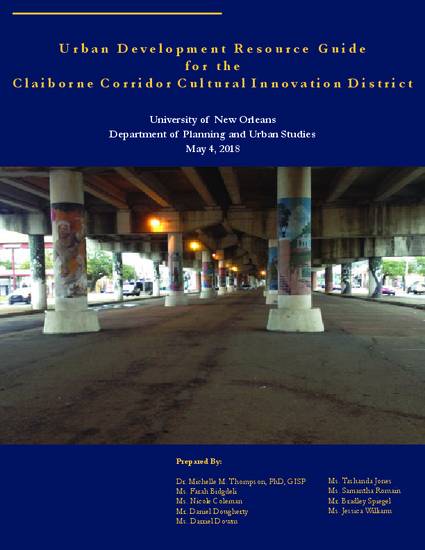
Unpublished Paper
Urban Development Resource Guide for the Claiborne Cultural Innovation District
(2018)
Abstract
The University of New Orleans Environmental Justice Planning Analyst team presents a broad-based
“Urban Development Resource Guide” designed to provide information on a wide variety of
urban development topics that are key subjects regarding future planning and development within
the Claiborne Corridor as well as its Cultural Innovation District.The Urban Development Resource Guide recognizes and recognizes that the Claiborne Corridor Cultural Innovation District (CCCID) will ultimately be defined by the residents, institutions, and local businesses that reside within the encompassing neighborhoods. The Cultural Innovation District has the potential to become a world-class example of how visionary planning and development can create a productive community driven area that provides a healthy local market space for arts, crafts, and produce vendors as well as shared community space for classrooms, exhibits, technology and educational demonstrations. It is vital that in the early stages of the Claiborne Corridor Cultural Innovations District’s development that both it as well as the community have access to updated and readily available information. The information should pertain to economic opportunity, housing, cultural and historical preservation, transportation access, environmental resilience, sustainability, and healthy safe neighborhoods. This guide is organized to provide information on the following:
1 - “Main Street” designation is and how it could benefit the Claiborne Corridor Cultural Innovation
District;
2 - National Historic Preservation Act’s Section 106 review process is, its overall requirements, and
finally its potential benefits to the Claiborne Corridor Culture Innovation District.
3 - Summarizes potential grant or fellowship funding sources that may be utilized by the District
or community members in order to help further the planning and development of the Claiborne
Corridor Cultural Innovation District.
4 - Brief summaries of up-to-date information including key topics that are central to accomplishing
the Claiborne Corridor Cultural Innovation District’s goals. The topics include: Government and
public safety; Religion and education; Demographics and economics; Historic buildings, places
and spaces; Land-use, parks, recreation and open space; Transportation, arts and culture; Housing;
and Public health and social services. The University of New Orleans Environmental Justice Planning Analyst team hope that the information included in the resource guide can be used by Claiborne Corridor Cultural Innovation District to further assist in future planning and development.
Keywords
- environmental justice,
- neighborhood planning,
- new urbanism,
- transportation,
- economic development
Disciplines
Publication Date
Spring May 4, 2018
Citation Information
Michelle M. Thompson, Farah Bidgeli, Nicole J Coleman, Daniel Dougherty, et al.. "Urban Development Resource Guide for the Claiborne Cultural Innovation District" (2018) Available at: http://works.bepress.com/michelle_m_thompson/72/
Creative Commons License

This work is licensed under a Creative Commons CC_BY International License.
